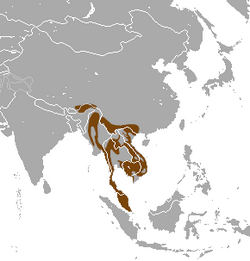Biology:Large-spotted civet
| Large-spotted civet | |
|---|---|

| |
| Drawing dated 1884 | |
| Scientific classification | |
| Domain: | Eukaryota |
| Kingdom: | Animalia |
| Phylum: | Chordata |
| Class: | Mammalia |
| Order: | Carnivora |
| Suborder: | Feliformia |
| Family: | Viverridae |
| Genus: | Viverra |
| Species: | V. megaspila
|
| Binomial name | |
| Viverra megaspila Blyth, 1862
| |

| |
| Large-spotted civet range | |
The large-spotted civet (Viverra megaspila) is a viverrid native to Southeast Asia that is listed as Endangered on the IUCN Red List.[1]
Characteristics
Pocock described the large-spotted civet as varying in colour from silvery-grey to golden-buff or tawny with a black to brown pattern and large or comparatively small spots, which are separated or sometimes fusing into blotches or into vertical stripes behind the shoulders. White bands on the tail are mostly restricted to the sides and lower surface but very seldom form complete rings. Adults measure 30–30.5 in (76–77 cm) in head and body with a 13–15.5 in (33–39 cm) long tail. Its weight ranges from 6.6–8.4 kg (14.5–18.5 lb).[2]
Distribution and habitat
The large-spotted civet occurs in Myanmar, Thailand, Malaysia, Cambodia, Laos, Vietnam and southern China . In China, it was last sighted in 1998.[1] It inhabits evergreen, deciduous, and dry dipterocarp forests below elevations of 300 m (980 ft). In Thailand, it occurs in several protected areas as far south as Ranong Province.[3]
Ecology and behaviour
Data on feeding ecology and behaviour of large-spotted civet do not exist.[1]
Threats
The large-spotted civet is threatened due to habitat degradation, habitat loss, and hunting with snares and dogs. The population is thought to have been steadily declining throughout the range countries, and in China and Vietnam in particular may have been reduced significantly.[1] In Chinese and Vietnamese markets, it is in demand as food.[4]
Taxonomic history
Pocock considered V. megaspila and V. civettina to be distinct species.[2] Ellerman and Morrison-Scott considered V. civettina a subspecies of V. megaspila.[5]
References
- ↑ 1.0 1.1 1.2 1.3 1.4 Timmins, R.; Duckworth, J.W.; WWF-Malaysia, Roberton, S.; Gray, T.N.E.; Willcox, D.H.A.; Chutipong, W.; Long, B. (2016). "Viverra megaspila". IUCN Red List of Threatened Species 2016: e.T41707A45220097. doi:10.2305/IUCN.UK.2016-1.RLTS.T41707A45220097.en. https://www.iucnredlist.org/species/41707/45220097. Retrieved 19 November 2021.
- ↑ 2.0 2.1 Pocock, R. I. (1939). "Moschothera megaspila (Blyth). The Large-spotted Civet". The fauna of British India, including Ceylon and Burma. Mammalia Volume 1. London: Taylor and Francis. pp. 356–358. https://archive.org/stream/PocockMammalia1/pocock1#page/n437/mode/2up.
- ↑ Lynam, A. J.; Maung, M.; Po, S.H.T.; Duckworth, J.W. (2005). "Recent records of Large-spotted Civet Viverra megaspila from Thailand and Myanmar". Small Carnivore Conservation 32: 8–11.
- ↑ Bell, D.; Roberton, S.; Hunter, P. R. (2004). "Animal origins of SARS coronavirus: possible links with the international trade in small carnivores". Philosophical Transactions of the Royal Society of London. Series B, Biological Sciences 359 (1447): 1107–1114. doi:10.1098/rstb.2004.1492. PMID 15306396.
- ↑ Ellerman, J.R. and Morrison-Scott, T.C.S. (1966). Checklist of Palaearctic and Indian Mammals 1758 to 1946. Second edition. British Museum of Natural History, London.
Wikidata ☰ Q922292 entry
 |


